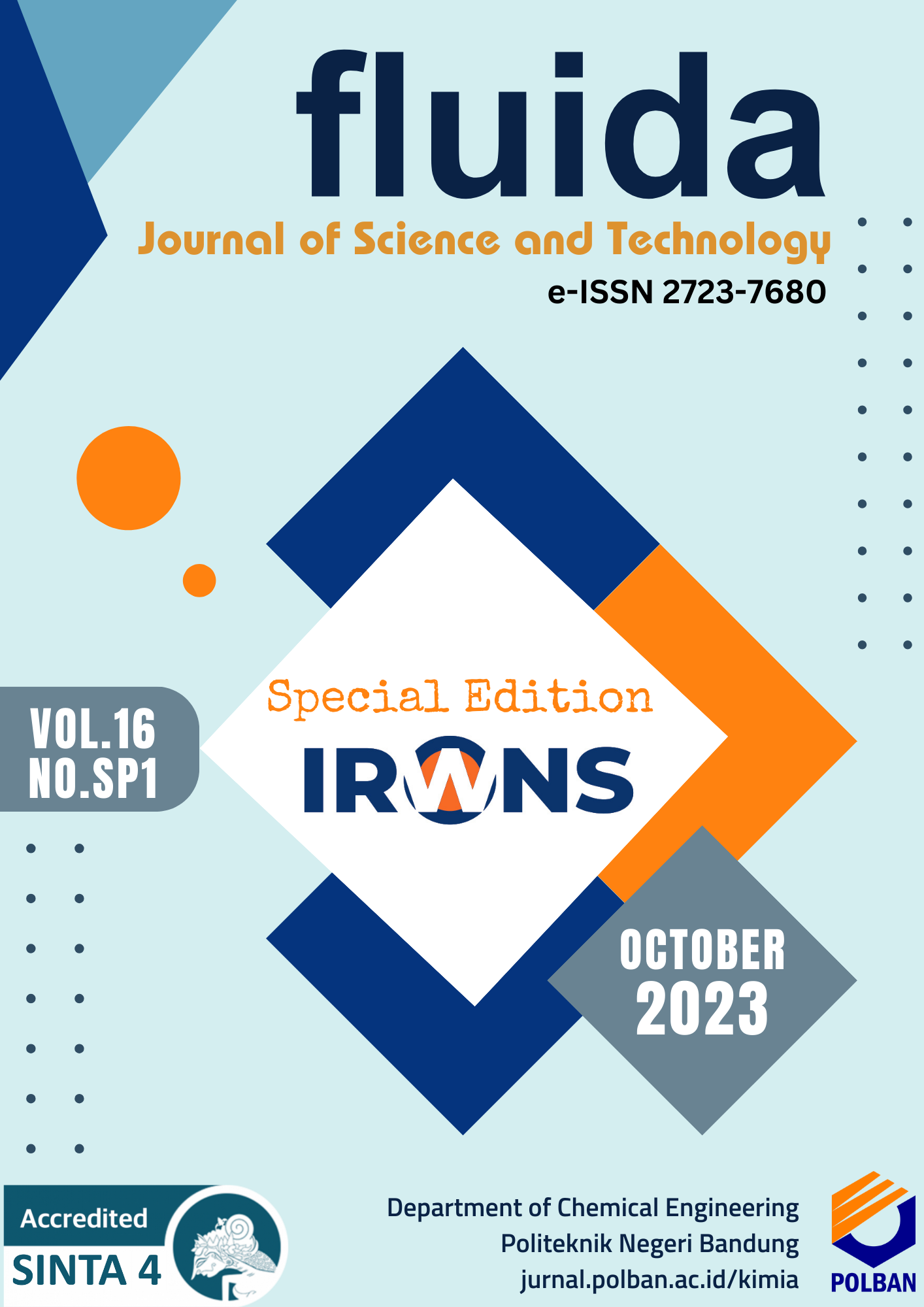Effect of Changes Turbidity on Oxygen Solubility in Fish Pond Water Electrocoagulation Process
Main Article Content
Abstract
The water used for fish farming by the Mina Lestari is very dirty, because many soil particles are dissolved in water. The water with high dirty in generally has very high turbidity. So that oxygen is difficult to dissolve in water and is not sufficient for fish life. So many fish die, due to insufficient oxygen for breathing. To reduce water turbidity is treated by electrocoagulation process combined with the aeration process. The aim of the research was to study the effect of changes in turbidity on dissolved oxygen in water. The study began by measuring the turbidity using a turbidimeter and dissolved oxygen using a DO meter. Furthermore, pour 10 liters of water into the electrocoagulation process tank. The electrocoagulation was carried out at 12 volt or 0,3 ampere for 10 minutes. The process was stopped, then the water flowed into the settling tank and left for 30 minutes to precipitate of the dirt. The water flowed into a holding tank and followed aeration process by flowing air at a rate of 500 cc per minute for 30 minutes. Then followed measuring turbidity by turbidimeter and dissolved oxygen by DO meter. Subsequent studies were carried out using the same procedure with an interval of 10 minutes processing time for electrocoagulation process. The results showed that an increase in processing time can reduce water turbidity from 68 NTU to 45 NTU or 33.82% and increase dissolved oxygen from 2.8 mg/L to 5.3 mg/L or 89.29% at 50 minutes processing.
Downloads
Article Details

This work is licensed under a Creative Commons Attribution-ShareAlike 4.0 International License.
An author who publishes in the FLUIDA journal agrees to the following terms:
- Author retains the copyright and grants the journal the right of first publication of the work simultaneously licensed under the Creative Commons Attribution-ShareAlike 4.0 License that allows others to share the work with an acknowledgement of the work's authorship and initial publication in this journal
- Author is able to enter into separate, additional contractual arrangements for the non-exclusive distribution of the journal's published version of the work (e.g., post it to an institutional repository or publish it in a book) with the acknowledgement of its initial publication in this journal.
- Author is permitted and encouraged to post his/her work online (e.g., in institutional repositories or on their website) prior to and during the submission process, as it can lead to productive exchanges, as well as earlier and greater citation of the published work (See The Effect of Open Access).
Read more about the Creative Commons Attribution-ShareAlike 4.0 Licence here: https://creativecommons.org/licenses/by-sa/4.0/.
References
N. Lusiana, B. R. Widiatmono, and H. Luthfiyana,” Beban Pencemaran BOD dan Karakteristik Oksigen Terlarut di Sungai Brantas Kota Malang,” Jurnal Ilmu Lingkungan, vol.18, no.2, pp. 354-366,Agst.2020, https://ejournal.undip.ac.id/index.php/ilmulingkungan/article/view/30365
A. Saputri, M.T.S. Johnny, and D. Rahayu,”Analisis Sebaran Oksigen Terlarut pada Sungai Raya,”Jurnal Teknologi Lingkungan Lahan Basah, vol.2, no.1, pp.1-10,2014, https://doi.org/10.14710/jil.18.2.354-366.
E. Salfia, Azhar, and M. Kamal, ”Rancang Bangun Alat Pengendalian dan Monitoring Kualitas Air Tambak Udang Berbasis Salinitas dan Kadar Oksigen Terlarut,” Jurnal Tektro, vol.2 , no.2 , pp. 2581-2890 Sept.2018, https://jurnal.untan.ac.id/index.php/jmtluntan/article/view/4618
H.W. Siegers, Y. Prayitno, and A. Sari, “Pengaruh Kualitas Air terhadap Pertumbuhan Ikan Nila Nirwana (Oreochromis sp.) pada Tambak Payau,” The Journal of Fisheries Development, vol. 3, no. 2, pp. 95 – 104, Juli 2019, https://core.ac.uk/download/pdf/229022288.pdf.
S.I. Patty, “ Karakteristik Fosfat, Nitrat dan Oksigen Terlarut di Perairan Selat Lembeh, Sulawesi Utara,”Jurnal Pesisir dan Laut Tropis, vol.2, no. 1, pp. 1-15,2015, https://doi.org/10.35800/jplt.3.2.2015.9581.
D. Madyawan, I. G. Hendrawan, and Y. Suteja,” Pemodelan Oksigen Terlarut (Dissolved Oxygen/DO) di Perairan Teluk Benoa,” Journal of Marine and Aquatic Sciences, vol. 6, no. 2, pp.270 - 280,2020, doi:https://doi.org/10.24843/jmas.
2020.v06.i02.p15
A. Purwanti, Sumarni, and A. Parjoko,” Koefisien Transfer Massa pada Ekstraksi Antosianin dari Bunga Dadap Merah,” Jurnal Teknik Kimia, vol.10, no.2, pp. 49 - 57, Apr. 2016, http://ejournal.upnjatim.ac.id/indx
php/tekkim/article/view/53.
F. Rosariawari, I. Wahjudijanto, and
T.A.Rachmanto,”Peningkatan Effektifitas Aerasi dengan Menggunakan Micro Bubble Generator (MBG)”, Jurnal Ilmiah Teknik Lingkungan, vol. 8,no. 2, pp. 88–97, 2016,http://eprints.upnjatim.ac.id/id/eprint/7323
P. A. Meneses, A. B.C. Salazar, J. T. M. Collana, J. A. R. Huamani, E. J. F. Gonzales, and G. E. R. Mendoza.“ Effects of the Operational Parameters in a Coupled Process of Electrocoagulation and Advanced Oxidation in the Removal of Turbidity in Wastewater from a Curtember”, Appl. Sci., vol. 12, no. 16, pp.1–14, Aug. 2022, doi: 10.3390/app12168158.
I.R. Abbas, R. S. A. Mukhtar, D.J.Mahdi, and M. Muayad, “Eliminate Turbidity and Oil from Polluted Water by Using the Electrocoagulation Process”, International Journal of Scholarly Research in Multidisciplinary Studies, vol. 2, no. 1, pp.1–9, Mar. 2023, doi: 10.56781/ijsrms.2023.2.1.0042.
N. Yahya, M. F. Mamat , S. Mamat, and N. A. Karim.“Chemical Oxygen Demand and Turbidity Removal of Landfill Leachate Using Electrocoagulation Technique with Al Electrode”, Malaysian Journal of Analytical Sciences, vol. 26, no 3, pp. 652-663, June 2022, https://mjas.analis.com.my/mjas 26_n3/pdf/Norilhamiah_26_3_19.
pdf.
C. A. Igwegbe, O. D. Onukwuli, and P.C. Onyechi,” Optimal Route for Turbidity removal from Aquaculture Wastewater by Electrocoagulation - Flocculation Process”, Journal of Engineering and Applied Sciences, vol. 15, no. 1, pp. 99-108,Dec.2019,https://www.researchgate.net/publication/337050114.
L. R. Mengistu, Z. A. Samue, C. D. Kitila , and A. B. Bayu ,”Comparison of sono-direct and sono-alternate current electrocoagulation processes for removal of color and turbidity from domestic wastewater”, Environmental Health Engineering and Management Journal, vol. 9, no. 2, pp. 177 - 188, May 2022,https://ehemj.com/browse.php?.a_id=952&sid=1&slc_lang=en&ftxt=1.
I. Moulood, and B. A. A.Majeed,” Treatment of Simulated Carwash Wastewater by Electrocoagulation with Sonic Energy”, Journal of Engineering, vol. 25, no. 9, pp. 30-40, Sep. 2019, https://www.iasj.net/iasj/download/b4cf7b64aa49f0d3.
M.S.Kowalski,E.P.X. Zhang, V. Wei,, and J.A. Oleszkiewicz,” Electrocoagulation of wastewater using aluminum, iron, and magnesium electrodes,” Journal of Hazardous Materials,368,pp.862-868, https://www.sciencedirect.com/science/article/abs/pii/S030438941830917.

